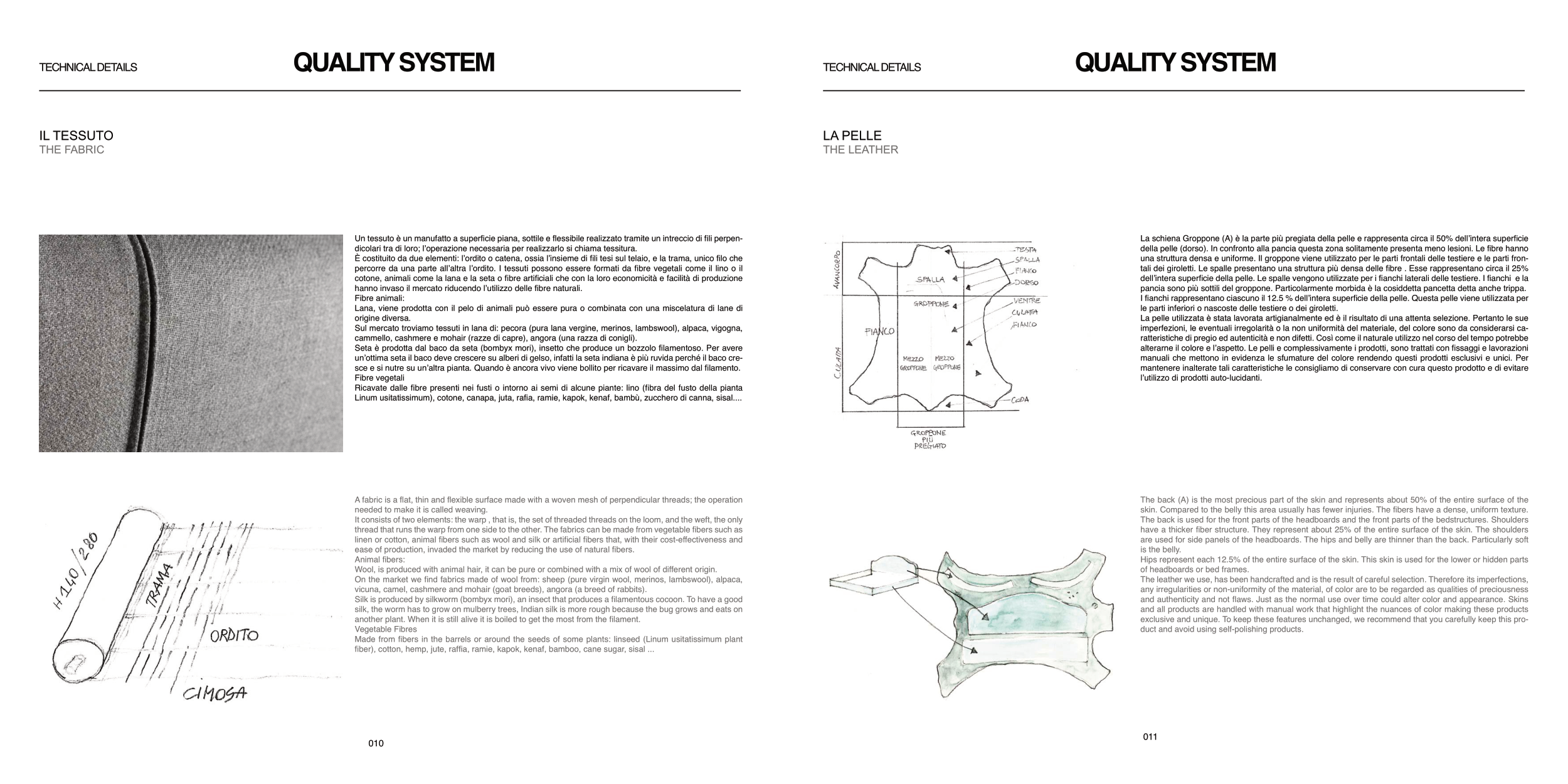TECHNICAL DETAILS QUALITY SYSTEM
Un tessuto è un manufatto a superficie piana, sottile e flessibile realizzato tramite un intreccio di fili perpen-
dicolari tra di loro; l’operazione necessaria per realizzarlo si chiama tessitura.
È costituito da due elementi: l’ordito o catena, ossia l’insieme di fili tesi sul telaio, e la trama, unico filo che
percorre da una parte all’altra l’ordito. I tessuti possono essere formati da fibre vegetali come il lino o il
cotone, animali come la lana e la seta o fibre artificiali che con la loro economicità e facilità di produzione
hanno invaso il mercato riducendo l’utilizzo delle fibre naturali.
Fibre animali:
Lana, viene prodotta con il pelo di animali può essere pura o combinata con una miscelatura di lane di
origine diversa.
Sul mercato troviamo tessuti in lana di: pecora (pura lana vergine, merinos, lambswool), alpaca, vigogna,
cammello, cashmere e mohair (razze di capre), angora (una razza di conigli).
Seta è prodotta dal baco da seta (bombyx mori), insetto che produce un bozzolo filamentoso. Per avere
un’ottima seta il baco deve crescere su alberi di gelso, infatti la seta indiana è più ruvida perché il baco cre-
sce e si nutre su un’altra pianta. Quando è ancora vivo viene bollito per ricavare il massimo dal filamento.
Fibre vegetali
Ricavate dalle fibre presenti nei fusti o intorno ai semi di alcune piante: lino (fibra del fusto della pianta
Linum usitatissimum), cotone, canapa, juta, rafia, ramie, kapok, kenaf, bambù, zucchero di canna, sisal....
A fabric is a flat, thin and flexible surface made with a woven mesh of perpendicular threads; the operation
needed to make it is called weaving.
It consists of two elements: the warp , that is, the set of threaded threads on the loom, and the weft, the only
thread that runs the warp from one side to the other. The fabrics can be made from vegetable fibers such as
linen or cotton, animal fibers such as wool and silk or artificial fibers that, with their cost-effectiveness and
ease of production, invaded the market by reducing the use of natural fibers.
Animal fibers:
Wool, is produced with animal hair, it can be pure or combined with a mix of wool of different origin.
On the market we find fabrics made of wool from: sheep (pure virgin wool, merinos, lambswool), alpaca,
vicuna, camel, cashmere and mohair (goat breeds), angora (a breed of rabbits).
Silk is produced by silkworm (bombyx mori), an insect that produces a filamentous cocoon. To have a good
silk, the worm has to grow on mulberry trees, Indian silk is more rough because the bug grows and eats on
another plant. When it is still alive it is boiled to get the most from the filament.
Vegetable Fibres
Made from fibers in the barrels or around the seeds of some plants: linseed (Linum usitatissimum plant
fiber), cotton, hemp, jute, raffia, ramie, kapok, kenaf, bamboo, cane sugar, sisal ...
IL TESSUTO
THE FABRIC
TECHNICAL DETAILS QUALITY SYSTEM
La schiena Groppone (A) è la parte più pregiata della pelle e rappresenta circa il 50% dell’intera superficie
della pelle (dorso). In confronto alla pancia questa zona solitamente presenta meno lesioni. Le fibre hanno
una struttura densa e uniforme. Il groppone viene utilizzato per le parti frontali delle testiere e le parti fron-
tali dei giroletti. Le spalle presentano una struttura più densa delle fibre . Esse rappresentano circa il 25%
dell’intera superficie della pelle. Le spalle vengono utilizzate per i fianchi laterali delle testiere. I fianchi e la
pancia sono più sottili del groppone. Particolarmente morbida è la cosiddetta pancetta detta anche trippa.
I fianchi rappresentano ciascuno il 12.5 % dell’intera superficie della pelle. Questa pelle viene utilizzata per
le parti inferiori o nascoste delle testiere o dei giroletti.
La pelle utilizzata è stata lavorata artigianalmente ed è il risultato di una attenta selezione. Pertanto le sue
imperfezioni, le eventuali irregolarità o la non uniformità del materiale, del colore sono da considerarsi ca-
ratteristiche di pregio ed autenticità e non difetti. Così come il naturale utilizzo nel corso del tempo potrebbe
alterarne il colore e l’aspetto. Le pelli e complessivamente i prodotti, sono trattati con fissaggi e lavorazioni
manuali che mettono in evidenza le sfumature del colore rendendo questi prodotti esclusivi e unici. Per
mantenere inalterate tali caratteristiche le consigliamo di conservare con cura questo prodotto e di evitare
l’utilizzo di prodotti auto-lucidanti.
LA PELLE
THE LEATHER
The back (A) is the most precious part of the skin and represents about 50% of the entire surface of the
skin. Compared to the belly this area usually has fewer injuries. The fibers have a dense, uniform texture.
The back is used for the front parts of the headboards and the front parts of the bedstructures. Shoulders
have a thicker fiber structure. They represent about 25% of the entire surface of the skin. The shoulders
are used for side panels of the headboards. The hips and belly are thinner than the back. Particularly soft
is the belly.
Hips represent each 12.5% of the entire surface of the skin. This skin is used for the lower or hidden parts
of headboards or bed frames.
The leather we use, has been handcrafted and is the result of careful selection. Therefore its imperfections,
any irregularities or non-uniformity of the material, of color are to be regarded as qualities of preciousness
and authenticity and not flaws. Just as the normal use over time could alter color and appearance. Skins
and all products are handled with manual work that highlight the nuances of color making these products
exclusive and unique. To keep these features unchanged, we recommend that you carefully keep this pro-
duct and avoid using self-polishing products.
010
011


